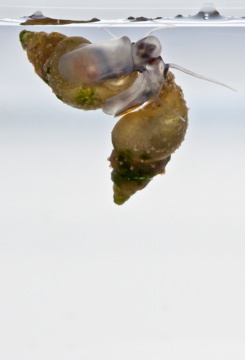In Lewis Carroll’s 1871 classic novel Through the Looking Glass, the Red Queen tells Alice: “Now, here, you see, it takes all the running you can do, to keep in the same place.”
Over the years, evolutionary biologists have used the Red Queen’s statement to refer to the “Red Queen” hypothesis, which describes how living organisms, including humans, manage to survive in a changing environment by adapting through sexual reproduction. According to a University of Iowa researcher, the hypothesis is supported.
In a paper published in the journal Biology Letters, lead author Deanna Soper, postdoctoral researcher in the UI Department of Biology and currently visiting assistant professor at Beloit College, Beloit, Wisconsin, and her colleagues write about testing a version of the Red Queen hypothesis.
In particular, they addressed whether a particular prediction of the hypothesis was met—that exposure to parasites increases multiple mating in New Zealand freshwater snails (Potamopyrgus antipodarum).

What they found was that a challenge to the health of the snails caused the snails to respond by increasing their rate of mating and their number of mates.
"Under the Red Queen hypothesis, sexual reproduction gives an advantage over asexual reproduction because sexually reproducing organisms ‘shuffle’ their genes during sex cell formation and fusion of sex cells from two individuals,” says Soper. “This means that the resulting offspring of sexually reproducing individuals may have an increased likelihood of escaping infection due to the production of unusual genetic backgrounds.
“Here, we test the prediction that exposure to parasites would increase mating behavior and number of sexual partners. We found that indeed parasites cause an increase in mating activity and promiscuity when exposed to parasites,” she says.
What Soper and her colleagues did was to expose the fresh-water snails to the eggs of a parasite that have the effect of sterilizing the snails. Interestingly, they found that such exposure caused both male and female snails to increase their sexual behavior.
At issue was the mystery of why sexual reproduction is so common among organisms and why it evolved in the first place—central questions in the field of evolutionary biology. After all, asexual females—which exist among freshwater snails and some other organisms—should be able to produce twice as many daughters as sexual females who produce both male and female offspring. Asexual reproduction would appear to have an advantage because only females produce offspring and females thus limit the rate at which populations grow.
In her summary, Soper speculates that multiple mating could increase genetic diversity among offspring, thereby making them more resistant to the risk of infection from parasites found in nature. She suggests that future studies investigate how other environmental factors influence mating behavior.
Her co-authors are: Kayla King of the University of Oxford, Daniela Vergara of the University of Colorado and Curt Lively of Indiana University.
The paper, whose title is “Exposure to parasites increases promiscuity in a freshwater snail,” can be found here.
The research was funded by grants from the National Science Foundation (#DEB-1110396 to Soper and #DEB-1110437 to Vergara), the National Geographic Society (#8835-10 to Vergara), the Royal Society to King, and the NSF Long Term Research in Environmental Biology (LTREB) program.